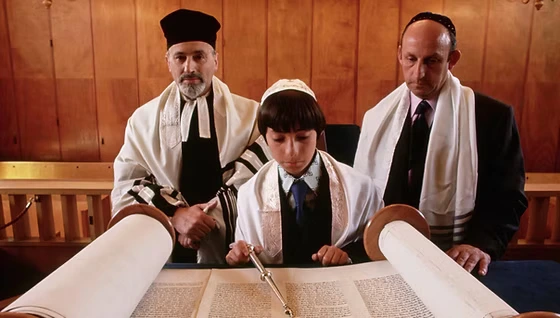
Bar Mitzvah is a significant milestone in Jewish culture, marking a young boy’s transition into adulthood at the age of 13. This cherished tradition is steeped in rich history, profound meaning, and vibrant celebrations that bring families and communities together. From the heartfelt moments shared during the ceremony to the lively festivities that follow, the Bar Mitzvah encapsulates the essence of Jewish heritage. In this blog, we will explore 25 interesting facts about Bar Mitzvah, delving into its origins, customs, and the various ways families celebrate this momentous occasion. Whether you’re preparing for a Bar Mitzvah or simply curious about this meaningful rite of passage, these insights will deepen your understanding of this beautiful tradition and its significance in the lives of Jewish families.
Definition: A Bar Mitzvah is a significant Jewish coming-of-age ceremony that marks the transition of a boy into adulthood at the age of 13. This age is considered the point at which a boy becomes morally and ethically responsible for his own actions according to Jewish law. The ceremony signifies that he is now obligated to observe the commandments (mitzvot) and participate fully in Jewish communal life, including prayer and other religious practices.
Meaning: The term “Bar Mitzvah” is derived from Aramaic, where “Bar” means “son” and “Mitzvah” means “commandment.” Thus, the phrase translates to “son of the commandment.” It reflects the boy’s new status as someone who is accountable for fulfilling the obligations of the Jewish faith. This new title is not just ceremonial; it carries with it the expectation that the individual will engage with their faith and community more actively.
First Bar Mitzvah: The first recorded Bar Mitzvah is believed to have occurred in the 13th century, although the practice likely existed in some form before this time. Historical sources suggest that the formalization of the Bar Mitzvah as a rite of passage became more defined during this period, coinciding with the development of Jewish law and custom. This evolution reflects the growing importance of education and religious obligation within Jewish communities.
Torah Reading: Central to the Bar Mitzvah ceremony is the reading from the Torah, which is the first five books of the Hebrew Bible. The boy typically reads a specific portion known as the “parashah,” which corresponds to the week of his Bar Mitzvah. This reading serves as a demonstration of his ability to engage with sacred texts and signifies his readiness to accept the responsibilities of Jewish adulthood. It is a moment of pride for the boy and his family, often accompanied by a celebration of this achievement.
Age of Responsibility: At the age of 13, a boy is considered to have reached the age of responsibility in Jewish law, known as “bar mitzvah.” This means he is now accountable for his actions and is expected to observe the 613 commandments outlined in the Torah. This transition is significant, as it marks the shift from childhood to a phase of life where moral and ethical decisions are taken seriously. The age of 13 has been recognized for centuries and is a pivotal moment in the boy’s spiritual journey.
Celebration: Bar Mitzvah celebrations can vary widely in scale and style, often reflecting the family’s traditions and cultural background. While some families opt for a simple gathering, others may host extravagant parties with hundreds of guests. These celebrations often include food, music, and dancing, creating a festive atmosphere that allows family and friends to come together in support of the Bar Mitzvah boy. The celebration is a way to honor the boy’s new status and to reinforce community bonds.
Kippah: During the Bar Mitzvah ceremony, it is customary for the boy to wear a kippah, also known as a yarmulke. This head covering symbolizes reverence and humility before God. The kippah is often worn by Jewish men during prayer and religious services, and its use during the Bar Mitzvah signifies the boy’s acceptance of his role in the Jewish community. It is also common for the kippah to be personalized for the occasion, sometimes featuring the date of the Bar Mitzvah or the boy’s name.
Tefillin: After the Bar Mitzvah, many boys begin to wear tefillin, which are small black leather boxes containing scrolls of parchment inscribed with verses from the Torah. Tefillin are worn during weekday morning prayers and serve as a physical reminder of the commandments. The practice of wearing tefillin begins at the Bar Mitzvah, marking the boy’s new responsibilities. This ritual emphasizes the connection between the individual and the divine, reinforcing the spiritual commitment that comes with reaching adulthood in the Jewish faith.
Aliyah: During the Bar Mitzvah ceremony, the boy is called to the Torah for an aliyah, which means “ascent” in Hebrew. This honor involves reciting a blessing before and after the Torah reading, signifying his new status as a Bar Mitzvah. The aliyah is a moment of great pride and is often accompanied by the applause and support of family and friends. This ritual not only marks his participation in the community but also symbolizes his acceptance of Jewish law and tradition.
Mitzvot: Following the Bar Mitzvah, the boy is expected to observe the mitzvot, which are the commandments outlined in Jewish law. There are a total of 613 mitzvot, which cover various aspects of daily life, ethical behavior, and religious practices. This includes obligations such as prayer, dietary laws (kashrut), and acts of kindness (gemilut chasadim). The acceptance of these responsibilities signifies the boy’s commitment to his faith and the Jewish community. Families often emphasize the importance of continuing education in Jewish traditions and laws, encouraging the Bar Mitzvah boy to deepen his understanding and practice of these commandments as he matures into adulthood.
Bar Mitzvah vs. Bat Mitzvah: A Bar Mitzvah is specifically for boys, while a Bat Mitzvah is the equivalent ceremony for girls, occurring at the age of 12. The term “Bat Mitzvah” translates to “daughter of the commandment.” While the Bar Mitzvah has been a recognized tradition for centuries, the Bat Mitzvah became more widely accepted in the 20th century, particularly within more progressive Jewish communities. The Bat Mitzvah ceremony may involve a Torah reading or other religious activities, and it signifies the girl’s coming of age and her responsibilities in observing Jewish law.
Bat Mitzvah: The Bat Mitzvah marks a significant milestone for girls in Judaism, similar to the Bar Mitzvah for boys. Traditionally held at age 12, the Bat Mitzvah signifies that a girl is now responsible for her own actions and is expected to observe Jewish commandments. The ceremony may vary in format depending on the community, with some girls reading from the Torah, while others may participate in a service or celebration that highlights their commitment to their faith. This growing recognition of the Bat Mitzvah reflects broader changes in Jewish practice and gender roles within the community.
Celebration Variations: Bar Mitzvah celebrations can range from intimate family gatherings to lavish parties with hundreds of guests. The scale and style of the celebration often reflect the family’s cultural background, religious observance, and personal preferences. Common elements include festive meals, music, dancing, and sometimes even themed decorations or entertainment. In some communities, it is customary to include a charitable aspect, where the Bar Mitzvah boy may choose to support a cause or organization, emphasizing the importance of giving back to the community.
Gifts: It is customary for guests to give gifts to the Bar Mitzvah boy, often in the form of money, which is traditionally given in multiples of 18, symbolizing “chai,” or life. Gifts can also include religious items, such as a tallit (prayer shawl) or a set of tefillin, which further emphasizes the boy’s new responsibilities. The act of giving gifts serves to celebrate the boy’s achievement and support his continued growth in faith and community involvement. Families often encourage their children to express gratitude for the gifts received and may also promote the idea of sharing a portion of the gifts with charitable organizations.
Charity: Many families encourage their Bar Mitzvah boys to donate a portion of their gifts to charity, reflecting the Jewish value of tzedakah, or justice and charity. This practice teaches the importance of giving back to the community and helping those in need. It is common for the Bar Mitzvah boy to select a charity that resonates with him personally, which can be a meaningful aspect of the celebration. This commitment to social responsibility reinforces the idea that with privilege and responsibility comes the obligation to support others.
Cultural Significance: The Bar Mitzvah is a culturally significant milestone in Jewish life, representing not only a personal achievement but also a rite of passage that connects the boy to his heritage and community. It serves as a moment for families to reflect on their traditions and values, and it often strengthens communal ties as friends and relatives come together to celebrate. The ceremony and its associated festivities create lasting memories and serve as a foundation for the boy’s ongoing relationship with his faith and culture.
Preparation: Preparing for a Bar Mitzvah typically involves several months of study and practice. Boys often work with a rabbi or tutor to learn Hebrew, understand their Torah portion, and become familiar with the prayers and rituals associated with the ceremony. This educational process not only equips them to participate in the service but also deepens their understanding of Jewish teachings and values. The preparation can be a transformative experience, as it encourages personal growth and a stronger connection to their faith.
Synagogue Service: The Bar Mitzvah ceremony usually takes place in a synagogue during a Shabbat service, which is the Jewish Sabbath. This setting emphasizes the communal aspect of the celebration, as the boy is welcomed into the congregation as a full member. The service typically includes prayers, readings from the Torah, and the boy’s aliyah. The presence of family, friends, and community members reinforces the importance of shared faith and collective celebration, making the occasion a communal milestone as much as a personal one.
Family Involvement: The Bar Mitzvah ceremony is a deeply familial event, often involving multiple generations of family members. Parents typically play a crucial role in preparing their child for this significant milestone, guiding them through the religious education necessary to understand their responsibilities as a Jewish adult. Grandparents often participate in the ceremony, sometimes being honored with special roles, such as giving blessings or sharing stories from their own Bar Mitzvah experiences. This involvement fosters a sense of continuity and connection to family heritage, emphasizing the importance of community and support during this pivotal moment in a young person’s life.
Celebration Duration: The duration of Bar Mitzvah celebrations can vary widely, ranging from a few hours for a simple ceremony to several days of festivities for larger, more elaborate events. Traditionally, the ceremony itself occurs on the child’s 13th birthday, where they read from the Torah during a synagogue service. Following the religious service, families may host a reception that can last several hours, featuring food, speeches, and dancing. In some cases, families choose to extend the celebration over a weekend, incorporating additional events like a Friday night dinner or a Sunday brunch, allowing for more time to gather with friends and family.
Photography: Professional photography is an integral part of Bar Mitzvah celebrations, as families often wish to capture the significance of this important milestone. Photographers are typically hired to document the ceremony, reception, and various family interactions throughout the day. These photographs serve as cherished keepsakes, allowing families to reflect on the joy and pride of the occasion for years to come. Many families also opt for creative photo booths or themed backdrops, encouraging guests to take fun pictures that contribute to the overall memories of the event.
Food: Traditional Jewish foods play a central role in Bar Mitzvah celebrations, reflecting cultural heritage and family traditions. Common menu items may include challah bread, brisket, kugel, and various side dishes, often accompanied by kosher wines. Desserts can range from classic items like rugelach and babka to elaborate cakes decorated to reflect the interests of the Bar Mitzvah boy. The food served is not only a way to nourish guests but also a means of celebrating Jewish culinary traditions, creating a festive atmosphere that brings everyone together.
Music: Music is an essential element of Bar Mitzvah celebrations, setting the tone for the festivities. Many families choose a mix of traditional Jewish songs, such as “Hava Nagila,” alongside contemporary popular music that appeals to guests of all ages. Live bands or DJs are often hired to provide entertainment during the reception, encouraging dancing and participation from guests. The selection of music can be personalized to reflect the interests of the Bar Mitzvah boy, creating a lively and enjoyable atmosphere that enhances the celebratory spirit of the event.
Community: The Bar Mitzvah is not only a personal milestone for the child but also a significant community event. Friends, family, and members of the synagogue are typically invited to partake in the celebration, reinforcing the sense of belonging within the Jewish community. This gathering serves as an opportunity for communal support and connection, as attendees come together to celebrate the child’s transition into adulthood. The presence of the community highlights the collective values and traditions that shape the Jewish identity, making the Bar Mitzvah a shared experience that extends beyond the individual.
Legacy: The Bar Mitzvah represents a vital connection to Jewish heritage, serving as a rite of passage that links the child to their cultural and religious roots. This event not only marks the child’s coming of age but also emphasizes the importance of responsibility within the Jewish faith. The teachings and values imparted during this time often leave a lasting impact, guiding the individual as they navigate their spiritual journey. By celebrating this milestone, families honor their legacy, instilling a sense of pride and continuity that resonates through future generations.
Frequently Asked Questions about Bar Mitzvah
1. What is a Bar Mitzvah?
A Bar Mitzvah (Hebrew: בר מצווה, “son of the commandment”) is a Jewish coming-of-age ceremony for boys, typically held when they turn 13. It signifies their acceptance of religious and ethical responsibilities within the Jewish community. While the core concept is the same, the specific customs and celebrations can vary slightly between different Jewish denominations (Orthodox, Conservative, Reform, etc.).
2. What happens during a Bar Mitzvah ceremony?
The Bar Mitzvah ceremony usually takes place in a synagogue during a Shabbat (Sabbath) service. The young man will typically:
- Lead parts of the service: This might include chanting prayers, reading from the Torah (the first five books of the Hebrew Bible), and sometimes leading the congregation in certain prayers. This demonstrates his growing knowledge and connection to Jewish tradition.
- Read from the Torah: A central part of the ceremony is the reading of a portion of the Torah. This is a significant undertaking, requiring months of preparation and study of Hebrew and the specific Torah portion.
- Deliver a D’var Torah (Torah talk): The Bar Mitzvah boy often prepares and delivers a short speech about the Torah portion he read, demonstrating his understanding and offering his own interpretation. This is a chance for him to share his insights and connect the ancient text to his own life.
- Receive blessings: The Rabbi and his family will offer blessings to the Bar Mitzvah, acknowledging his transition and wishing him well in his Jewish journey.
3. What is the significance of a Bar Mitzvah?
The Bar Mitzvah marks the transition from childhood to adulthood within the Jewish faith. It signifies that the boy is now considered religiously responsible for his actions and is obligated to observe Jewish commandments (mitzvot). He is now counted as part of the minyan (the quorum of ten men required for communal prayer) and can participate more fully in synagogue life. Beyond the religious aspects, it’s also a significant personal milestone, a celebration of the young man’s growth and learning.
4. How does a boy prepare for his Bar Mitzvah?
Preparing for a Bar Mitzvah involves a significant amount of study and practice. This typically includes:
- Hebrew lessons: Learning to read and understand Hebrew is essential for reading from the Torah and participating in the service.
- Torah study: The Bar Mitzvah boy will work with a tutor (often the Rabbi or a specialized teacher) to learn the specific Torah portion he will read, as well as its meaning and context.
- Prayer practice: He will practice chanting prayers and leading parts of the service.
- D’var Torah preparation: He will research and write his D’var Torah, often with guidance from his Rabbi or a mentor.
- Mitzvah observance: He will learn about and begin to practice various mitzvot, further integrating Jewish traditions into his daily life.
5. What is the difference between a Bar Mitzvah and a Bat Mitzvah?
While a Bar Mitzvah is for boys, a Bat Mitzvah is a similar coming-of-age ceremony for girls. The specific customs and timing of a Bat Mitzvah can vary depending on the community and denomination. In many communities, girls celebrate their Bat Mitzvah at age 12, while in others it’s at 13. Like the Bar Mitzvah, the Bat Mitzvah marks the girl’s transition into religious adulthood and her acceptance of religious responsibilities.
6. Is a Bar Mitzvah a party?
The Bar Mitzvah ceremony itself is a religious service. However, it is customary to celebrate this milestone with a party or reception following the service. This is a time for family and friends to come together to celebrate with the Bar Mitzvah boy and his family. The party can range from a small gathering to a large and elaborate event.
7. What kind of gifts are appropriate for a Bar Mitzvah?
Gifts for a Bar Mitzvah should be thoughtful and appropriate for the occasion. Common gifts include:
- Monetary gifts: Gifts of money are often appreciated, especially as the family has likely incurred significant expenses in preparing for the Bar Mitzvah. The amount is traditionally given in multiples of 18 (chai, which means “life” in Hebrew), such as $18, $36, $54, etc.
- Religious items: These might include a tallit (prayer shawl), tefillin (phylacteries), a siddur (prayer book), or a piece of Judaica.
- Books: Books of Jewish interest, such as biographies, history books, or books on Jewish ethics, are also appropriate.
- Experiences: Tickets to a cultural event, a gift certificate to a restaurant, or a donation to the Bar Mitzvah boy’s favorite charity in his name can also be thoughtful gifts.
8. What should I wear to a Bar Mitzvah?
The dress code for a Bar Mitzvah typically depends on the synagogue and the family’s level of observance. Generally, it’s appropriate to dress respectfully and modestly.
- Men: Men often wear a suit and tie, or at least dress pants and a collared shirt. If the service is in a more traditional synagogue, a kippah (yarmulke) may be required (and often provided).
- Women: Women should wear modest clothing, such as a dress or skirt and top. Shoulders should be covered, and skirts should fall below the knee. In some synagogues, women may also be asked to cover their hair.
9. How long does a Bar Mitzvah service last?
The length of a Bar Mitzvah service can vary, but it typically lasts between 1.5 and 3 hours, depending on the synagogue, the specific service, and the length of the Torah reading and D’var Torah.
10. What if I’m not Jewish but I’m invited to a Bar Mitzvah?
If you are not Jewish and you are invited to a Bar Mitzvah, it is a kind gesture to attend and share in the family’s celebration. It’s a good opportunity to learn more about Jewish traditions. Simply be respectful of the religious ceremony, dress appropriately, and offer your congratulations to the Bar Mitzvah boy and his family. If you are unsure about what to expect or what is appropriate behavior, it’s always a good idea to ask the host family for guidance.









